Introduction. Responding to the lack of services and spaces dedicated to Asian Americans and drawing inspiration from the Black Power and the Third World Liberation movements of the late 1960s, a community-based arts and activist group known as Basement Workshop emerged during the 1970s as a revolutionary and countercultural organization [1]. Basement was one of the first self-identified Asian American arts collectives in New York at the time of which “Asian American” was still an under-coined idea [2]. This special exhibition takes a social and historical approach to understand the importance and legacy of Basement Workshop, collectively and through members’ works, and to, more importantly, document, celebrate, and uphold its many accomplishments by examining the theme of reciprocity (giving and receiving) starting with its inception and weaving this concept throughout its many inspiring and radical initiatives, namely English and language citizenship classes for adult Chinese immigrants, its publications Bridge (1971-1978) and Yellow Pearl (1972), the Chinatown Health Fair (1971), and beyond.
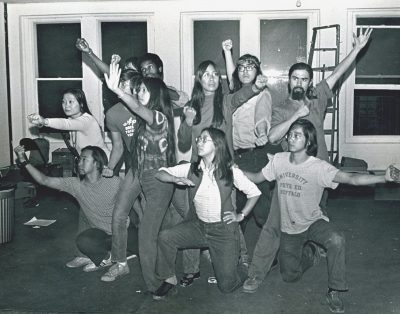
Reciprocity is ingrained and survives beyond the formal (in)existence of Basement, as members continued to engage in various arts and forms of advocacy through different variants that emerged out of the umbrella organization even when it “closed” in 1986 [3]. Honoring the inherently collective and collaborative nature of Basement Workshop, this exhibition includes participatory approaches to the curation of artifacts seen in this special exhibition in addition to other selected artifacts. Three seminal Basement Workshop members—Tomie Arai, Arlan Huang, and Theodora [Teddy] Yoshikami—each selected and donated artifacts based on their experiences with Basement and discussed the objects’ significance for this exhibition.
Origins of Basement: Reciprocity as Radical Resistance. Inherent to the inception of Basement Workshop is the concept of reciprocity as well as collectivity and grassroots organizing. In 1969, Danny N.T. Yung, an urban planning student at the time, was commissioned by the Ford Foundation to conduct research focusing on Chinatown, specifically its economy, crime, poverty, as well as the need for social services [3]. This foundational work conducted by Yung and others, known as the Chinatown Study Group and the Chinatown Report 1969, would lead to the first-ever research focusing on New York City Chinatown. After the completion of the report, Danny Yung, Eleanor Yung, Peter Pan, Frank Ching, and Rocky Chin found space in a basement located on 54 Elizabeth St. in New York City Chinatown to continue their work. This modest space became a central gathering hub for young and budding artists and activists to come together. 54 Elizabeth St. was the very first of Basement’s many locations [1, 3]. Eleanor Yung, sister of Danny Yung, described the simple space as approximately 16’ x 16’ with a small window in one corner.
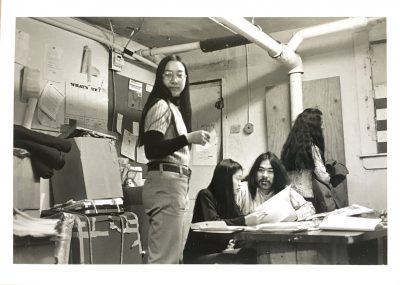
However, what would be accomplished within that 16’ x 16’ space was nothing short of simple. Ultimately, Basement Workshop Inc. legally came into existence thanks to five individuals who signed their names onto legal paper and dozens of other individuals who selflessly paid rent, raised funds, and volunteered endlessly to sustain the space and more importantly their visions for Basement [4]. While the origins story of Basement Workshop was initially heavily rooted in giving in terms of reciprocity, Basement did receive help from others as well. Archival materials indicate that Basement “networked with, argued with, and were inspired by” [5] a variety of groups including but not limited to Yellow Brotherhood, Visual Communications in L.A., Kearny Street Workshop, Asian American Theater workshop, and more. This process of reciprocation can be seen in the ways that Basement members connected with other groups, each mutually invigorating one another, including hosting one another. An archived document reveals: “From the west coast artist and activists visited and stayed at Basement, just as Basement activists returned the favor” [5]. Tomie Arai further emphasizes the reciprocal nature of Basement’s work. Noting that “[Basement was] so much of giving.” When asked about the receiving component of reciprocity, she noted that Basement was influenced by Third World movements:
“I don’t think we knew; I’m saying this in retrospect,—we really didn’t know what was going on in a lot of those countries but I remember studying Mao’s lecture on Yan’an forum and art and culture with Basement members in a study group” [6].
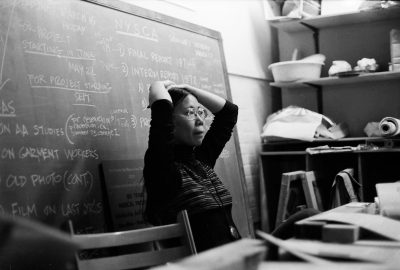
In regards to more tangible benefits, Basement received help later down the road when Fay Chiang, who became the director of Basement Workshop around 1978, needed a larger space to keep up with the expansion of Basement. An interview with Theodora (Teddy) Yoshikami revealed that a man by the name of Carlos “Chino” Garcia of CHARAS, helped Chiang “put in the infrastructure of the Lafayette space along with a few Chinatown People” [7]. While Basement gave to and received help from the community, Basement’s individual members also intimately engaged with the process of reciprocity. In fact, Arai alluded to such a reciprocal effect:
“So many of the young people who joined Basement and Yellow Pearl…they’re really beginning to try to understand who they were…how they could really shape their own identities…I felt like Basement was…an example of something that came out of a real need for [this] kind of space, for people who are really searching…for a way to express themselves and to really find a place for themselves, not just in Chinatown, but in the world, around them, and it was possible in those days, to create those…spaces. Because I often think about…the 60s and 70s, [they] were a time when people were really thinking very deeply about alternatives to exist…”[6].
In other words, participating in Basement afforded members space to not only affect the larger Asian American community but also to explore and embrace their Asian identity, a sentiment that was also shared by Arlan Huang:
“And I think the most amazing thing to me at that time, was all these young Asian Americans grew up in a situation where they were the only Asian Americans in the class. And everybody was so happy to see the Asian Americans with similar situations. I was surprised because I grew up in San Francisco Chinatown. All my friends were pretty much Asians. So, when I heard that I can see the absolute joy in people talking to other Asians. Now I was really amazed. And that was new for me” [8].
As Huang highlights, integral to this idea of reciprocity is love and care for other people’s happiness and well-being. This idea is further emphasized by Yoshikami who described at length how Fay Chiang, executive director of Basement, tirelessly dedicated herself to the organization. “Fay gave of her time and energy throughout freely even dropping out of college to run Basement” [7]. The care that the women had for one another, the larger organization, and vice versa was evident; One year, when Yoshikami worked at Basement full-time, Yoshikami encouraged Chiang to return to college to finish her undergraduate degree. Meanwhile, for Yoshikami, she had the opportunity to bring her daughter to work, a work set-up that was not common during the time. Yoshikami also shared how Basement helped her to realize her plans “to create Asian American contemporary dance and Fay Chiang also realized she could use some help running some daily, weekly, and monthly tasks” [7]. Yoshikami and Chiang, and Basement in general, mutually benefitted from and supported one another’s work and presence.
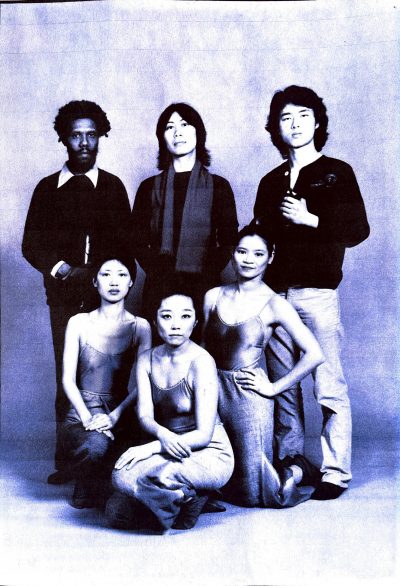
For her chosen artifact, Arai selected a poster that she created on behalf of Basement and shared how artists were able to use Basement as a personal space for growth and to draw support from one another.
“But I guess I share this with you because this was sort of a way that I learned how to be an artist through Basement, and learn how to figure out a channel or a way to get to making a living. I think, people were in the same boat, I mean, a lot of people were doing photography for the first time. And then when they went on to become photographers, or they were writing poetry and went on to become…recognized poets. There were people who did…acting for the first time and went on to become performers. And so, I feel like it became, it was sort of, in many ways a training ground. But it was a way that we really encouraged each other to learn skills to share skills to share knowledge to there. It wasn’t a judgmental place, I have to say, I mean…virtually anything you did people accepted” [7].
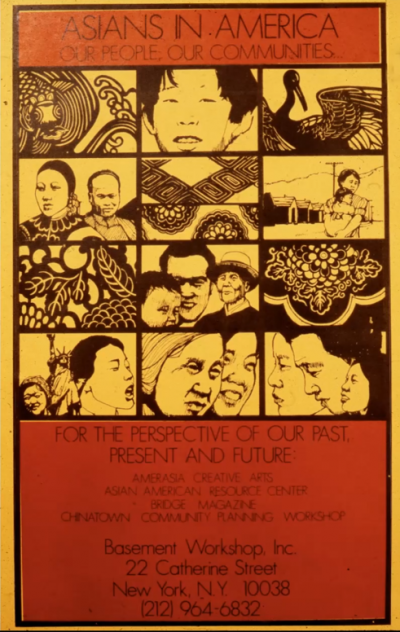
Ultimately, the inception, as well as the continued existence, of Basement Workshop was rooted in and sustained by radical reciprocity. Members sacrificed so much, many putting a pause on their education or leaving school entirely, and the majority working without pay. When asked why such sacrifices were made, Huang responded:
“Well, I think the, during those times, it was an audacious time. I think people ran on a very romantic notion that revolution was a real possibility. So…it was really dedicated to changing this society. And [Basement] was important enough not to go to school, because school seemed to be really irrelevant to what we were doing. [Basement] was very important” [8].
Further, Huang also noted that people, at the time, volunteered determinedly without expecting monetary compensation as a way to resist capitalism whilst paying a nod to the trickiness of nonprofits. Yoshikami confirmed this generosity and sacrifice:
“During the earlier years, [Basement] was a completely volunteer situation and no one got paid. People volunteered to do these projects as in the case of printing the Yellow Pearl packet. Many, as I stated, eventually had to leave to obtain paying jobs. Once Fay Chiang became director, more like around ‘78, she eventually raised more monies to hire people to run programs including paying for any supplies. These projects didn’t start until mid-80’s…While at BW, I was the only ‘full time’ staff. The others were paid only for times they ran workshops. Fay never paid herself. She always volunteered” [7].
Basement members relentlessly contributed their time, energy, and talents to Basement and to one another with unmatched care and dedication during a time where there were little to no spaces that did the same for them.
Collaboratively curated images obtained through interviews with Tomie Arai, Arlan Huang, Teddy Yoshikami, shared with permission.
Reciprocity in Initiatives: For the Community, By the Community. To fully appreciate and realize the impact of Basement’s (selected) initiatives, Arai provides further social and geopolitical context from which the various initiatives arose. Arai shares:
“And, you know, part of that had to do with the fact that there was such a lack of social services for Chinatown residents in particular… And I think that a lot of those kinds of services and basic needs were provided historically by the benevolent associations…the fact that Chinatown was, in many respects, a ghetto that you know, existed because there was so much discrimination outside of…the Chinatown community, Chinese community. It meant that they had to provide for themselves. They had to create those means of helping each other to survive and navigate the whole system here in America and learn how to be resilient on their own” [6].
Here, Arai explicitly notes the systems that forced the community to become resilient. In other words, Basement members recognized gaps in the community and filled those gaps themselves. One of the many original initiatives intended to “help each other survive,” as Arai puts it, included Basement’s adult English language and citizenship classes, which ran weekly and were conducted through the Community Planning Workshop, a community arm of Basement [3, 9]. In fact, Chiang also described the classes as “survival English and citizenship classes” that would reach 200 community adults [9]. Other groundbreaking works including Bridge Magazine, which started in 1979 and ended its affiliation with Basement Workshop in 1985 [1, 10]. Like many of the other initiatives, Bridge arose out of a need to address the Asian American experience given that, at the time, mainstream American press centered the experiences of the white majority. As such, Bridge became an alternative that offered diverse perspectives on social issues concerning the Asian (American) experience domestically and internationally, acting metaphorically as a bridge “between Asian American groups” [10].
Similarly, Yellow Pearl (1972), an anthology containing 57 prints on heavy yellow paper featured the artwork, music, and writings from approximately 30 various Basement members that were inspired by folk singers Chris Iijima, Nobuko Miyamoto, and Charlie Chin [1, 11]. Yellow Pearl, named after one of the group’s songs, was also a clever play on the term “yellow peril”, a racist slogan that was used to provoke anti-Asian sentiment across the U.S., became a seminal piece that represented the emerging consciousness of Asian American identity during its time [11].
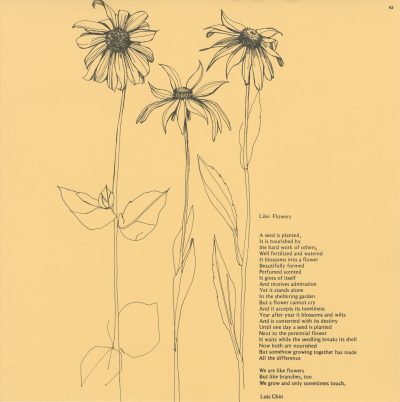
In fact, sales from both Bridge Magazine and Yellow Pearl provided some modest revenue for Basement though the overwhelming majority of work was, as previously mentioned, driven by hard volunteer work and sacrifices made by Basement members [3, 9]. Lastly, we highlight the Chinatown Health Fair (1971), which came into existence after Basement members noted how Chinatown residents, many of whom were residents themselves, lacked access to adequate health care. Inspired by the Civil Rights Movement, members surveyed the community’s medical needs whilst providing health services in collaboration with a variety of healthcare workers. This one street health fair gave rise to what is now known as the Charles B. Wang Community Health Center [12]. In sum, the existence of Basement was revolutionary in and of itself just as its many initiatives proved to be.
Archived documents of the Chinatown Street Health Fair sourced from the archives of the New York Times and Asian/Pacific/American Institute at NYU.
Special thanks to Ms. Tomie Arai, Mr. Arlan Huang, and Ms. Teddy Yoshikami for their time, expertise, and all they have done and continue to do for the broader Asian American community. We thank you for taking the time to review the article and for providing extensive feedback and suggestions. We also want to thank Ms. Laura Chen-Schultz for tirelessly helping us secure permissions for the images outside of the artist-selected artifacts.
Interviewed Artists Biographies
Tomie Arai. Arai is a “sansei” or third-generation Japanese American born in New York City who largely attributes her education to lived experience and mentors. Widely known as a visual artist and community activist, Arai became involved with Basement Workshop in 1972 through Yellow Pearl and by working on a mural called A History of Chinese Immigration to the U.S. Arai would then go on to direct a vertically-oriented mural called the Wall of Respect for Working People of Chinatown (1977), which was painted on the side of the Music Palace theater [13]. Arai was heavily involved with street murals as a graphic artist, creating brochures and posters to help gain attention to Asian American struggles. Arai and Huang worked together on many different murals throughout New York City that displayed Asian American activism and appreciation. Arai has continued to dedicate her efforts to the Asian American community co-founding The Chinatown Art Brigade with artists Betty Yu and ManSee Kong [14].
Arlan Huang. Huang is a third-generation Chinese American who was born in Bangor, Maine, and raised in San Francisco. Known for his paintings, sculptures, installations, and public art, Huang became intimately involved with Yellow Pearl in 1971 as he took on the tremendous challenge of overseeing the development and production of the anthology in conjunction with Takashi Yanagida [15]. In the same year of the Yellow Pearl publication, Huang received his B.F.A. from the Pratt Institute in 1972. Huang, Arai, and Yoshikami all exhibited through Basement Workshop. Huang has done extensive work as a solo artist and collaboratively; Huang made a series of murals for the City Arts Workshop, which became another opportunity for Huang and Arai to collaborate together. Further, Huang, and others, are credited as active founders of the Asian American Movement, Asian American Studies, the Asian American women’s movement, and more [16].
Teddy Yoshikami. Yoshikami is a “sansei” or third-generation Japanese American born in Tule Lake, California, an American concentration camp. Known for her choreography, Yoshikami became one of the first Asian Americans to create choreography focused on Asian American themes with Asian American dancers. Educated in the U.S. and recipient of several fellowships for projects in Japan, Mongolia, Cambodia, and Vietnam, Yoshikami received an MA in Performance Studies from the NYU Graduate School of Arts. Yoshikami participated in various roles through Basement; in 1970-1972, Yoshikami conducted modern dance classes with Eleanor Yung. In 1978, Yoshikami received a prestigious federal fellowship administered by NYC from the CETA arts grant. As required by the fellowship, she found a community organization sponsor, Basement Workshop, and provided dance classes to the community as seen pictured below. Through the grant, Yoshikami would then go on to start her own dance company, Morita Dance Company. She also provided Chiang assistance by keeping accounting records, including reports to the Federal, State, City, and Basement’s accountant.
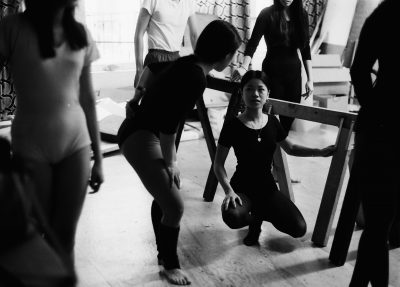
An ongoing exhibition project curated by Melanie Yu in collaboration (in Spring 2021) with Joselyn Cueto, Yi Tuo, Jose Monzon Barillas, Ashley Mejia
References
1. Chang, Alexandra. 2011. Basement Workshop. Vol. 1. Oxford University Press. https://doi.org/10.1093/gao/9781884446054.article.T2094011.
2. “Histories of Activism in Chinatown.” n.d. A Blade of Grass (blog). Accessed April 23, 2021. https://www.abladeofgrass.org/reports-from-the-field/histories-activism-chinatown/.
3. Wong, Ryan Lee. n.d. “Basement Workshop The Genesis of New York’s Asian American Resistance Culture.” Signal:06.
4. Yung, Eleanor. 2009. “Photograph of Group Portrait of the Basement Workshop, [1972].” 2009. https://artasiamerica.org/documents/7128.
5. University of Washington. n.d. “Art for the Community: A Short History of Basement Workshop in New York.” https://staff.washington.edu/kendo/basement.html.
6. Tomie Arai. 2021. Tomie Arai Zoom Interview with Melanie Yu.
7. Teddy Yoshikami Phone Interview with Melanie Yu. 2021.
8. Arlan Huang Zoom Interview with Melanie Yu. 2021.
9. Chiang, Fay. 1988. “Looking Back.” Journal of Arts Management and Law 18 (2): 62–68. https://doi.org/10.1080/07335113.1988.9942190.
10. “Bridge Magazine – Museum of Chinese in America.” n.d. Accessed April 25, 2021. https://www.mocanyc.org/collections/stories/bridge-magazine/.
11. “Yellow Pearl – Museum of Chinese in America.” n.d. Accessed April 25, 2021. https://www.mocanyc.org/collections/stories/yellow-pearl/.
12. “Chinatown Street Fair.” n.d. National Museum of American History. Accessed April 25, 2021. https://americanhistory.si.edu/collections/search/object/nmah_1900087.
13. Wong, Ryan. 2017. “A Brief History of the Art Collectives of NYC’s Chinatown.” Hyperallergic. February 7, 2017. https://hyperallergic.com/330442/a-brief-history-of-the-art-collectives-of-nycs-chinatown/.
14. “About the Artist.” n.d. Tomie Arai. Accessed April 25, 2021. https://tomiearai.com/about.
15. Karen L. Ishizuka. 2016. Serve the People Making Asian America in the Long Sixties. Verso Books.
16. “Online Events.” n.d. Smithsonian Institution. Accessed April 25, 2021. https://www.si.edu/events/online.


